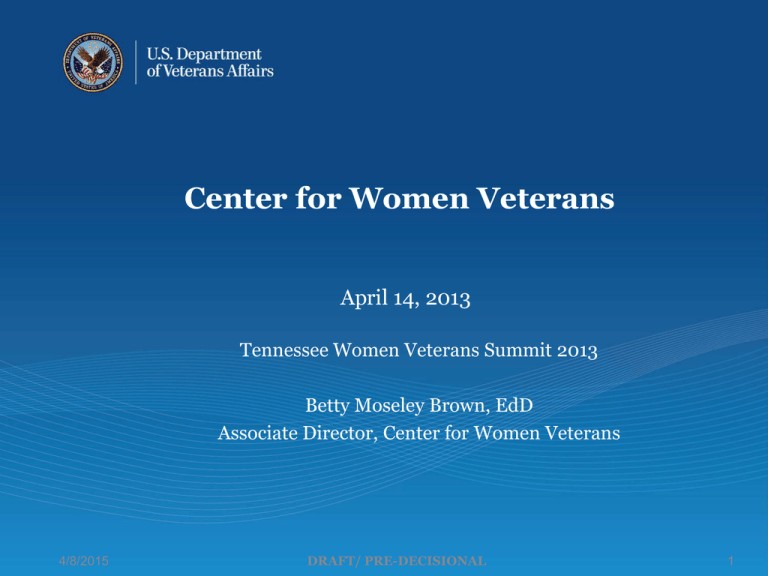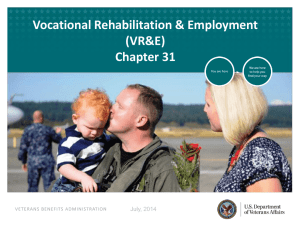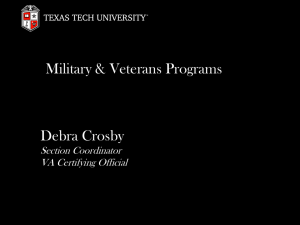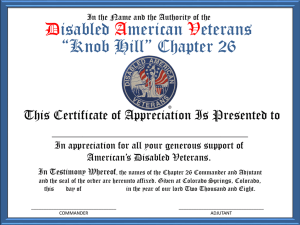Dr. Betty Moseley-Brown-VA Center for Women Veterans
advertisement

Center for Women Veterans April 14, 2013 Tennessee Women Veterans Summit 2013 Betty Moseley Brown, EdD Associate Director, Center for Women Veterans 4/8/2015 DRAFT/ PRE-DECISIONAL 1 Overview Congressional Mandate How Other Organizations Can Help Our Mission – What we Do Objectives of Center for Women Veterans Partnerships 2011 National Training Summit on Women Veterans How Women Veterans Can Obtain Local Assistance Did You Know? “Make the Connection Campaign” Summary-Where We Are Going How to Contact the Center Women Veterans Demographics Women Veterans Challenges Initiatives to Address Challenges How the Center Uses Partnerships Are You Ready to Serve VA Women Veterans-Specific Resources 2 Congressional Mandate November 1994, Public Law 103-446 required VA to create The Center for Women Veterans to monitor and coordinate VA programs for women 3 Our Mission – What We Do Monitor and coordinate VA’s administration of health care and benefits services, and programs for women Veterans. Serve as an advocate for a cultural transformation (both within VA and in the general public) in recognizing the service and contributions of women Veterans and women in the military. Raise awareness of the responsibility to treat women Veterans with dignity and respect. 4 Objectives of Center for Women Veterans (Center) Partnerships To improve extended knowledge among partners to enhance outreach to women Veterans. To describe how joint outreach is marketed to make women Veterans aware of their benefits and services. To create collaborative partnerships with DoD and other federal, state and local organizations to raise awareness of VA benefits and services to women Veterans. 5 Women Veterans Demographics One of the fastest growing Veterans subpopulation. Based on active duty and recruiting numbers, the percentage of female Veterans is projected to increase. By 2020, VA projects that 10.5 percent of Veterans we serve will be women Veterans. 2.24 million living women Veterans of the 22.3 million Veterans (VetPop as of 9/30/12). 20 percent of all military recruits are women. Median female Veteran’s age is 49; male Veteran’s age is 64 (as of 9/30/12). 6 Women Veterans Challenges Many women Veterans do not self identify as Veterans. Many are not aware of and do not apply for VA’s benefits and services. In some areas, access to VA’s gender-specific care may be limited – use fee basis and contracts. Disparities in health care – VHA established the Office of Health Equity to address issues. Lower utilization: Outreaching to women Veterans who live in rural areas and on American Indian Reservations, and who are low income, or elderly. 7 Women VHA Users Doubled Since 2000 2012: 360,000 2000: 159,000 4/2013 8 Gender-Specific Programs 4/2013 9 Health Care Available for Women Veterans General Care 4/2013 10 Health evaluation and counseling Disease prevention Nutrition counseling Weight control Smoking cessation Substance abuse counseling and treatment Gender-specific primary care Cervical cancer screens (Pap smears) Breast cancer screens (mammograms) Birth control Preconception counseling and care Maternity & newborn care Human Papillomavirus (HPV) vaccine Menopausal support (hormone replacement therapy) Emergency services for women Veterans Health Care Available for Women Veterans Mental health care Evaluation and assistance for depression, mood, and anxiety disorders Intimate partner and domestic violence Military sexual trauma Elder abuse or neglect Parenting and anger management Marital, caregiver, or family-related stress Post-deployment adjustment or post-traumatic stress disorder (PTSD) 4/2013 11 Informing Women Veterans www.womenshealth.va.gov FAQs and Fact Sheets Social Media Messaging Women Targeted Health Campaigns Information Videos (internal/external) 4/2013 12 Meeting the Needs of Women Veterans Research is a key component in VA's initiative to improve services for women Veterans. VA has just released a report which examines the demographic profile of female VA patients—who they are, how old they are, where they live and how they use VA. The report, Sourcebook: Women Veterans in the Veterans Health Administration–Volume 2 (5.2 MB, PDF), presents data that will inform policy and planning as VA looks at new ways of providing care to women Veterans. 4/2013 13 Making Women Veterans a Priority at VA Changing the VA Culture • Women Veterans Health Care is leading a VA-wide communication initiative to enhance the language, practice and culture of VA to be more inclusive of women Veterans 4/2013 14 Targeting Critical Health Care Issues for Women Veterans and VA Staff 4/2013 15 1 Minute Favorite… 4/8/2015 16 Benefits Assistance for Women Veterans VA increasing outreach to women Veterans for faster, easier access to benefits and assistance • Established full-time Women Veteran Coordinators in all Regional Offices • Launched women Veterans outreach call center in June 2011 – Contacted more than 18,000 women Veterans since inception • Developed benefits pamphlet exclusively on gender specific disabilities • Deploying eBenefits Enhanced User Personalization tailored specifically for women Veterans eBenefits: online 24/7 access to benefits, health and employment information: www.ebenefits.va.gov 17 Expanding Access: Outreach to Women Veterans Barbara Herman, Sacramento National Cemetery, shares information with a U.S. Air Force Veteran at a March 2013 event honoring military women Keeping the Promise, Together 18 Expanding Access: NCA Outreach/ Mobile Command Vehicle Keeping the Promise, Together 19 Caring for those who have borne the battle…. Interment of World War II Marine Margaret A. Osgood and 32 other Unclaimed Veterans and Spouses at Quantico National Cemetery, VA, March 16, 2013 Keeping the Promise, Together 20 Initiatives to Address Challenges Joint outreach to educate and raise awareness about eligibility. Enhancement of Center for Women Veterans Website to educate about VA’s programs, on Facebook, VA Blog, Twitter, etc. Usage of fee basis and contracts when appropriate. Work with VA Administrations, and other Federal agencies to address disparities in care and services availability. VHA established the Office of Health Equity to address issues. 21 VA Women Veterans-Specific Resources Full-time women Veterans program managers (WVPM) at VA health care facilities across the country to outreach to women Veterans and assist them with accessing VA’s health care services. Designated women Veterans coordinators (WVC) at all 56 VA regional offices (RO); staff trained on serving women Veterans (specifically on military sexual trauma claims). VA presence on social media sites: Blog, Twitter, Facebook, Flickr, and YouTube. Collaboration across program offices, stakeholders, and nonVA agencies to enhance mental health and homeless services among women Veterans. 22 How other Organizations can Help with Outreach Serve as an advocate for women Veterans. Raise awareness and educate women, so they will self identify and understand the benefits to which they are entitled. Encourage women Veterans to apply for benefits and services, such as compensation for injuries or illnesses incurred during military service, home loans, GI Bill for education, Vocational Rehabilitation and Employment Training, and health care, etc. 23 How Other Organizations Can Help with Outreach Collaborate and work with local WVPMs and WVCs, Vet Centers, Community Based Outpatient Clinics and Veterans service organizations to facilitate Veterans’ access to services. Invite VA subject matter experts to present at various joint outreach local programs on services. Provide temporary financial assistance to help women Veterans, especially those with children, and those who are at risk for homelessness where possible. Collaborate with local community and faith-based agencies that offer food and clothing assistance for women Veterans, especially those with children. 24 2011 National Training Summit on Women Veterans Key themes: 1. Culture Change 2. Gender-Specific Comprehensive Primary Care 3. Role of Women Veterans Program Managers (WVPMs) 4. Outreach and Marketing 5. Proficient Health Care Providers for Women Veterans 6. Agency Collaboration 7. Patient-Centered Care and Patient Aligned Care Teams (PACT) 8. Homelessness 9. Military Sexual Trauma (MST) 10. Privacy, Safety, and Environment of Care (EOC) 25 Summary - Where We Are Going The Women Veterans Program (WVP) was officially transferred to the Center for Women Veterans on September 11, 2012 to identify gaps in services and identify opportunities to better serve women Veterans, and then develop results-oriented recommendations to decisively advance VA’s efforts to address women Veterans’ needs. Enhancing access and joint outreach efforts – a Secretarial priority. Connecting women Veterans with knowledge of VA benefits and services through educational events, mass media and technology. 26 Summary - Where We Are Going Continuously promoting recognition of women Veterans’ service and contributions of women Veterans and women in the military, e.g. “Her Story” campaign, “the Right Place” PSA, and “Please Don’t Call Me Mister” campaigns. 27 How to Contact the Center Staff Members: Dr. Betty Moseley Brown Desiree Long Shannon Middleton Michelle Terry Juanita Mullen (American Indian Liaison) Major Khanh T. Diep Address: Department of Veterans Affairs Center for Women Veterans (00W) 810 Vermont Ave., NW Washington, DC 20420 Phone: 202-461-6193 Fax: 202-273-7092 Website: www.va.gov/womenvet Email: 00W@mail.va.gov 28







